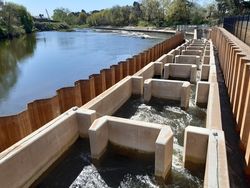Unlocking the Severn
After a gap of 180 years, migratory fish will finally swim up the River Severn once again this spring. This annual miracle of nature was halted by the building of weirs across the river in Victorian times, but the opening of new fish passes allows species like the twaite shad access to spawning grounds upriver.
Unlocking the Severn has been an ambitious project to build four large fish passes that bypass weirs at Diglis, Bevere, Holt Heath and Lincombe near Stouport-on-Severn. The project began in the autumn of 2018 and after four years, despite the challenges of successive lockdowns, work is now complete.
So why do fish like the twaite shad matter? Shad used to be so common on the river through Worcester that it was part of the diet of people living in the city. Around 1840, engineers built weirs to raise river levels to make it navigable for larger boats. From that moment the fish could no longer swim upriver and their numbers dwindled.
Today the twaite shad is listed as an endangered species across Europe. A few remaining fish get as far as Worcester each year and these have been tagged by scientists who have discovered them migrating from here to north Devon and even Ireland.
Now the fish passes are ready, they will finally be able to reach their spawning grounds in the upper Severn again. The hope is that this will lead to a rebound in their population, improving the ecology of the river.
The passes also help other fish such as migrating salmon. So far 23 species of fish have been recorded at the Diglis fish pass. This huge structure measures 100 metres long and is 8 metres deep and is arguably the most ambitious engineering project in the river in Worcestershire since the Victorians built the weirs. The Diglis fish pass has an underwater window that allows the public to watch the fish swim upriver. Their migration is also monitored by cameras that collect data on the numbers passing through.
Exactly how they find their way back to the Severn each year is one of the mysteries of nature, but once they come here, they should return to the same spawning ground for the rest of their lives. The timing of the migration depends on spring tides and water temperature, but all being well this will be at the end of April or the start of May. Once their eggs are laid, the shad swim downriver again, finally leaving the Severn a month later.
The last time shad swam past Worcester, Victoria had recently ascended the throne. Since then, 35 generations of shad have been unable to return home, something that is finally about to change.
SEE THE SHAD RETURN!
This spring you can join a tour of Diglis Island that includes the opportunity to see shad for yourself through a giant underwater window built into the fish pass. There will also be activities and events centred around 21st May which is World Fish Migration Day. For further information and booking nearer the time please visit unlockingthesevern.co.uk


